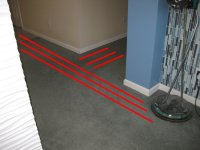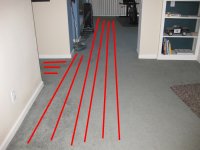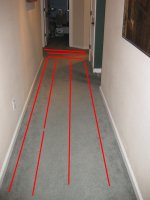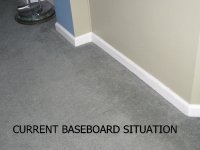copcarcollector
Member
- Joined
- Jan 11, 2013
- Messages
- 1,455
I am an OK DIY-er, and have a ton of tools [laughing] But, I have never done anything this large on my own.
I want to install wood flooring in my house. Currently I have carpet over plywood subfloor over a crawl space. Once I remove the carpet, I had planned to add extra screws to the plywood into the joists to eliminate squeaks, then roll out the underlayment and then install the wood floors on top. I do not have any materials yet, just in the beginning planning phase right now.
So I have several questions:
1) Can I add any heating below a wood floor in my situation? It would have to be electric mats, I do not have radiators so no hot water type system. I am concerned about cold floors in the winter. It does get to and below freezing here for short periods of time.
2) Baseboards - major sticking point in my mind right now. I have a lot of existing baseboards, and would prefer to not remove them. Is it possible to leave them in place and install a wood floor underneath the existing baseboards? I do not like the look of 1/4 round added where the base meets the floor. I am just trying to eliminate a lot of work, is it better to just take them out and put them back once the new floor is in?
3) Where to stop! I have two large rooms, and a hallway planned - is it preferred to stop and leave bedrooms carpeted, or just continue the wood flooring everywhere? Same question for the kitchen, currently a vinyl floor, should the wood continue into the kitchen as well? I think it would look all cohesive for everything to be done in wood, just costly!
4) Is it OK to have the wood meet at right angles? Do I need to leave any space for expansion/contraction at a 90 degree angle? See pictures - the red lines represent the proposed layout, having the wood run the long way from front to back of the house, then long down the hallway instead of a bunch of short pieces. Hope I explained this OK.
5) Anything else I should consider before I tear out the carpet and start? Any materials to use or not to use, tricks, tips etc... Anyone want to come and install it for me for free---?!
I appreciate any help. If you need clarification on anything let me know!
Jeff
Carson City, NV
[attachimg=#]
[attachimg=#]
[attachimg=#]
[attachimg=#]
I want to install wood flooring in my house. Currently I have carpet over plywood subfloor over a crawl space. Once I remove the carpet, I had planned to add extra screws to the plywood into the joists to eliminate squeaks, then roll out the underlayment and then install the wood floors on top. I do not have any materials yet, just in the beginning planning phase right now.
So I have several questions:
1) Can I add any heating below a wood floor in my situation? It would have to be electric mats, I do not have radiators so no hot water type system. I am concerned about cold floors in the winter. It does get to and below freezing here for short periods of time.
2) Baseboards - major sticking point in my mind right now. I have a lot of existing baseboards, and would prefer to not remove them. Is it possible to leave them in place and install a wood floor underneath the existing baseboards? I do not like the look of 1/4 round added where the base meets the floor. I am just trying to eliminate a lot of work, is it better to just take them out and put them back once the new floor is in?
3) Where to stop! I have two large rooms, and a hallway planned - is it preferred to stop and leave bedrooms carpeted, or just continue the wood flooring everywhere? Same question for the kitchen, currently a vinyl floor, should the wood continue into the kitchen as well? I think it would look all cohesive for everything to be done in wood, just costly!
4) Is it OK to have the wood meet at right angles? Do I need to leave any space for expansion/contraction at a 90 degree angle? See pictures - the red lines represent the proposed layout, having the wood run the long way from front to back of the house, then long down the hallway instead of a bunch of short pieces. Hope I explained this OK.
5) Anything else I should consider before I tear out the carpet and start? Any materials to use or not to use, tricks, tips etc... Anyone want to come and install it for me for free---?!
I appreciate any help. If you need clarification on anything let me know!
Jeff
Carson City, NV
[attachimg=#]
[attachimg=#]
[attachimg=#]
[attachimg=#]




